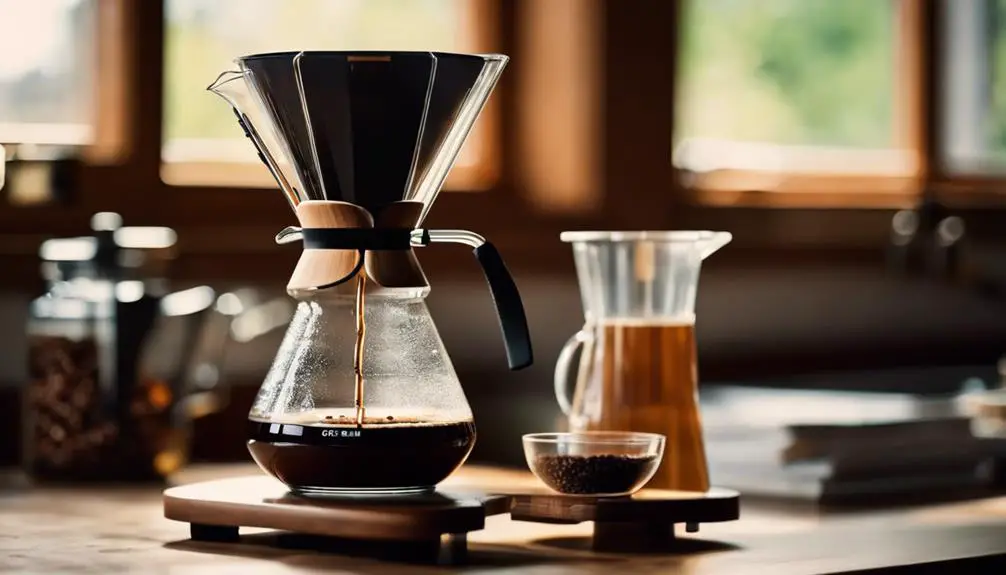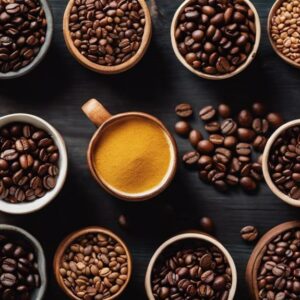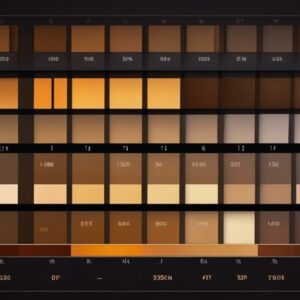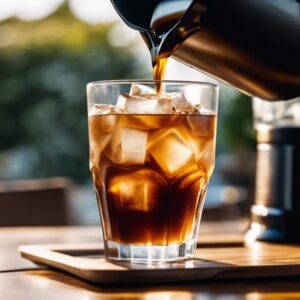You might not be aware that achieving a truly acid-free brew involves more than just selecting low-acidity coffee beans. The key lies in the brewing method itself.
Have you ever considered how the brewing process affects the acidity levels in your cup of coffee? Understanding the nuances of low acidity brewing methods can significantly impact the flavor profile of your coffee.
By mastering these techniques, you can unlock a whole new world of smooth, mellow coffee experiences.
Comprehensive Guide to Low Acidity Brewing Methods
If you want to enjoy coffee without the sharp acidity, consider trying different brewing methods.
Cold brew is great for a smooth, low-acid coffee, while a French press can offer a richer and smoother taste.
AeroPress allows you to control the acidity levels, and adjusting your drip brewing technique or trying pour-over can also help reduce acidity in your cup.
Cold Brew Method for Low Acidity
If you want to enjoy a smooth and mellow cup of coffee without the sharp acidity, the cold brew method might be your go-to.
Discover the essentials of cold brewing to reduce acidity levels, follow a step-by-step guide to the cold brew process, and explore tailored recipes designed for a low acidity profile.
Get ready to savor a refreshing and gentle coffee experience with these cold brew techniques.
Essentials of Cold Brewing for Reduced Acidity
To achieve a smoother and less acidic coffee experience, mastering the cold brew method is essential.
- Experiment with acidic fruit pairings for unique flavor profiles.
- Explore pH balance techniques to control acidity levels.
- Utilize different brewing times and temperatures to tailor your cold brew to perfection.
Enhance your coffee journey by delving into the world of cold brewing for reduced acidity while unlocking a spectrum of innovative flavors.
Step-by-Step Cold Brew Process
Begin by selecting coarsely ground coffee beans and cold, filtered water for the cold brew process.
- Grind Consistency: Ensure the coffee beans are coarsely ground for optimal extraction.
- Brewing Time: Let the coffee steep in the refrigerator for 12-24 hours for a smooth, low-acidity brew.
- Filtration Method: Strain the concentrate using a fine mesh sieve for a clean finish.
Cold Brew Recipes Tailored for Low Acidity
Begin by selecting coarsely ground coffee beans and cold, filtered water for the cold brew process to craft a smooth, low-acidity brew. Enhance your cold brew experience with innovative variations such as adding acidic fruit pairings like lemon or raspberry for a unique twist. Experiment with different brewing times and ratios to tailor your cold brew to suit your taste preferences perfectly.
| Cold Brew Variations | Acidic Fruit Pairings | Best Brew Time |
|---|---|---|
| Lemon Twist | Lemon | 14 hours |
| Raspberry Ripple | Raspberry | 16 hours |
| Orange Zest | Orange | 12 hours |
French Press Technique for Smoother Coffee
When brewing with a French press for smoother coffee, remember to adjust settings for a less acidic result.
Pay close attention to water temperature and grind size – they play crucial roles in achieving low acidity.
Experiment with different French press recipes to find the perfect balance for a smoother, less acidic cup of coffee.
Fine-Tuning French Press Settings for Less Acid
To achieve a smoother, less acidic brew using a French press, adjust the grind size and steeping time according to your taste preferences and the coffee beans you’re using.
- Grind Size: Experiment with different grind sizes to find the one that suits your preference.
- Steeping Time: Adjust the time you let the coffee steep to control the strength of the brew.
- Bean Variety: Different beans may require specific settings for optimal flavor extraction.
The Role of Water Temperature and Grind Size
For achieving a smoother and less acidic brew in your French press, pay close attention to the water temperature and grind size you use. Water quality impact plays a crucial role in acidity control, while grind consistency directly affects acidity levels. Ensuring the right combination of these factors can lead to a more balanced and enjoyable coffee experience.
| Water Quality Impact | Acidity Control | Grind Consistency | Acidity Levels |
|---|---|---|---|
| High-quality water | Helps control acidity | Consistent grind size | Affects the final acidity |
| Proper mineral content | Can reduce acidity | Uniform particle size | Determines coffee taste |
| Temperature consistency | Impacts flavor profile | Adjust based on taste preference | Fine grind may increase acidity |
| Clean water | Prevents off-flavors | Coarse grind reduces over-extraction | Coarse grind may decrease acidity |
| Filtered water | Enhances coffee nuances | Adjust to balance acidity | Adjust to balance bitterness |
French Press Recipes for Lower Acidity
Explore unique French press recipes that are specifically crafted to lower acidity levels, enhancing the smoothness of your coffee experience. When aiming for a milder flavor profile, consider adjusting brewing techniques for a more balanced cup. Below are some innovative ideas to help you achieve a smoother brew:
| Brewing Techniques | Flavor Profiles |
|---|---|
| Coarse Grind Size | Nutty |
| Longer Steep Time | Chocolatey |
| Lower Water Temperature | Caramel |
| Gentle Plunge Pressure | Rich |
| Double Filtration Method | Smooth |
AeroPress Method for Acidity Control
Ready to master the AeroPress method for controlling acidity in your coffee?
Discover why the AeroPress is a great tool for achieving a low acidity brew.
Learn how to adjust variables for a smoother cup.
Explore specific techniques to manage acidity levels effectively.
Let’s brew up some delicious, low-acid coffee with the AeroPress!
Why AeroPress is Suitable for Low Acidity Brewing
AeroPress proves its suitability for low acidity brewing due to its versatile brewing capabilities and efficient extraction process.
- Versatile Brew Styles: Allows for various brewing techniques, accommodating different preferences.
- Enhanced Flavor Profiles: Produces rich, smooth coffee with low acidity, enhancing the overall taste experience.
- Quick Extraction: Delivers a clean cup of coffee in a short time, perfect for those seeking an acid-free brew.
Adjusting AeroPress Variables for Lower Acidity
To achieve a lower acidity level in your AeroPress coffee, consider fine-tuning the brewing variables for a smoother, milder taste profile. When using the AeroPress immersion method, adjusting variables like water temperature and steeping time can help control acidity levels. Experiment with different grind sizes and agitation techniques to customize your brew for a more balanced flavor experience. Check the table below for a quick reference guide on AeroPress variables adjustment.
| Variable | Adjustment | Effect |
|---|---|---|
| Water Temperature | Lower temperature | Reduces acidity |
| Steeping Time | Shorter time | Decreases acidity |
| Grind Size | Coarser grind | Lowers acidity level |
| Agitation Technique | Gentle stirring | Minimizes acidity |
| Water-to-Coffee Ratio | Increase coffee ratio | Dilutes acidity |
AeroPress Brewing Techniques for Acid Management
Consider adjusting the AeroPress brewing techniques to effectively manage acidity levels in your coffee for a more balanced flavor experience.
- Enhance Aeropress pressure: Utilize varying pressure during brewing to control acidity levels.
- Optimize Aeropress extraction: Experiment with different extraction times for better taste balance.
- Fine-tune acidity control: Adjust grind size and water temperature to achieve desired acidity levels in your coffee.
Drip Brewing Adjustments for Lower Acidity
When aiming for lower acidity in your coffee, start by choosing the right filter type for your drip brewing method.
Make adjustments to your drip brewing technique by tweaking variables like water temperature, grind size, and brewing time to reduce the acidity in your cup.
Selecting the Right Filter Type
Considering your brewing method for lower acidity, the type of filter you choose can significantly impact the flavor profile of your coffee.
- Paper Filters: Provide a clean taste by trapping oils and sediments.
- Metal Filters: Allow more oils through, resulting in a richer body.
- Cloth Filters: Offer a balanced flavor by allowing some oils while still filtering out sediments.
Drip Brewing Tips for Reducing Acidity
To enhance the low acidity profile of your coffee through drip brewing, adjusting the grind size and water temperature can play a crucial role in achieving a smoother flavor profile.
- Grind Size: Opt for a coarser grind to reduce over-extraction and acidity.
- Water Temperature: Use slightly cooler water to minimize the extraction of acidic compounds.
- Brewing Time: Shorten the brewing time to avoid over-extraction of acids.
Pour-Over Technique for Acidity Reduction
If you want to master the Pour-Over technique for lower acidity coffee, focus on:
- Grind size
- Water temperature
- Pouring technique
These key factors can significantly impact the acidity levels in your brew. By adjusting these variables, you can achieve a smoother, more balanced cup of coffee with reduced acidity.
Mastery of Pour-Over for Low Acidity Coffee
For those seeking a smoother and less acidic coffee experience, mastering the pour-over technique is essential.
- Consistent Pouring: Maintain a steady, controlled pour to ensure even extraction.
- Proper Water Temperature: Use water just below boiling to avoid over-extraction and bitterness.
- Quality Coffee Beans: Start with freshly roasted beans for a more vibrant flavor profile.
Mastering these elements will elevate your low acidity pour-over brew to new heights.
Impact of Grind Size, Water Temperature, and Technique
Master the impact of grind size, water temperature, and technique to achieve the perfect low acidity brew using the pour-over method. Water quality directly affects acidity levels, while roast levels can help control acidity. Experiment with different grind sizes and temperatures to find your ideal balance. Check out the table below for a quick reference on how these factors influence your brew’s acidity levels.
| Factors | Impact on Acidity |
|---|---|
| Water Quality | High |
| Roast Level | Control |
| Grind Size | Variable |
| Water Temperature | Variable |
Exploring Other Methods: Moka Pot, Chicory, and Mushroom Coffee
If you’re looking to venture beyond traditional brewing methods, consider trying out the Moka Pot for a smoother coffee experience with lower acidity.
Chicory coffee offers a unique twist with its naturally lower acidity levels, providing a different flavor profile to explore.
Additionally, the emerging trend of mushroom coffee presents an intriguing option for those seeking a low acidity alternative in their daily brew.
Moka Pot Brewing for Low Acid Coffee
Brewing coffee with a Moka pot is a popular choice for those seeking a low acidity coffee experience.
Moka Pot Tips:
- Grind your coffee beans finely for best results.
- Use filtered water to enhance the flavor.
- Avoid overheating the Moka pot to prevent bitterness.
For an even lower acidity brew, consider trying out different acidic bean alternatives to suit your taste preferences.
Chicory Coffee: An Alternative with Lower Acidity
Consider incorporating chicory coffee into your brewing routine for a unique and flavorful low acidity alternative.
- Explore Herbal Alternatives: Chicory offers a herbal twist to your coffee experience.
- Discover Acid Neutral Options: Chicory coffee provides a smooth taste without the acidity.
- Embrace Innovation: Try chicory coffee for a new and exciting way to enjoy a lower acidity brew.
Mushroom Coffee as a Low Acidity Trend
Discover the intriguing world of mushroom coffee, a rising trend in low acidity brewing methods that offers a unique and earthy alternative to traditional coffee drinks.
- Mushroom coffee benefits: Enhanced focus and energy without the jitters.
- Low acidity coffee alternatives: Smooth and slightly nutty flavors.
- Taste: Earthy and rich profile that sets it apart from regular coffee blends.
Optimizing Brewing Conditions for Low Acidity
To achieve low acidity in your coffee, pay close attention to the water temperature, as it plays a critical role in the brewing process.
Adjusting the grind size can also help reduce acidity levels, so experiment with different settings to find what works best for you.
The Critical Role of Water Temperature
When brewing coffee for low acidity, you must pay close attention to the water temperature. Different brewing methods require specific temperature ranges to achieve the desired flavor profile. To help you understand the ideal temperatures for each method, refer to the table below.
| Brewing Method | Ideal Temperature Range |
|---|---|
| Pour Over | 195-205°F |
| French Press | 200°F |
| Cold Brew | Room temperature or cold water |
Ideal Temperature Ranges for Each Brewing Method
For each brewing method, understanding the ideal temperature ranges is crucial in achieving low acidity in your coffee. Different brewing techniques require specific water temperatures to optimize flavor extraction and minimize acidity. Below is a table outlining the optimal temperature ranges for popular brewing methods:
| Brewing Method | Ideal Temperature Range |
|---|---|
| Pour Over | 195-205°F |
| French Press | 200°F |
| Cold Brew | Room temperature |
| Aeropress | 175-185°F |
The Significance of Grind Size in Reducing Acidity
When aiming to reduce acidity in your coffee, the grind size plays a crucial role. The right grind size can optimize your brewing conditions for a smoother, less acidic cup. Understanding the relationship between grind size and acidity levels can help you achieve the perfect balance in your coffee.
| Importance of Grind Size in Reducing Acidity |
|---|
| Enhances Extraction Efficiency |
| Affects Brewing Time |
| Impacts Flavor Profile |
Finding the Perfect Grind for Each Method
To achieve the best results in reducing acidity levels, adjust your grind size according to the brewing method you are using. Precision in grind consistency and brewing time is key to mastering an acid-free brew. Below is a table outlining the ideal grind size for different brewing methods:
| Brewing Method | Ideal Grind Size |
|---|---|
| Pour Over | Medium |
| French Press | Coarse |
| Espresso | Fine |
| Aeropress | Fine to Medium |
| Cold Brew | Coarse |
The Influence of Brewing Time on Acidity
When brewing coffee, timing is crucial in determining the acidity level. You can optimize the acidity of your coffee by adjusting the brewing time to suit your preferences. Experimenting with different brewing times can help you find the perfect balance between flavor and acidity.
| Timing (Minutes) | Acidity Level |
|---|---|
| 2 | Low |
| 4 | Medium-Low |
| 6 | Medium |
| 8 | High |
Guidelines for Timing to Optimize Acidity Levels
For optimal acidity levels in your low coffee acidity brew, consider the influence of brewing time on the flavor profile.
- Experiment with shorter brewing times to reduce acidity levels.
- Longer brewing times can intensify the acidity in your coffee.
- Find the perfect balance by adjusting your brewing time to achieve your desired acidity level.
Filters and Accessories for Low Acidity Brewing

When considering low acidity brewing, you’ll want to weigh the pros and cons of using paper versus metal filters. These filters can significantly impact the final taste of your coffee.
Additionally, having the right tools can make a noticeable difference in achieving that perfect cup of low acidity coffee.
Paper vs. Metal Filters: A Comparison
Consider the type of filter you use when brewing coffee as it can significantly impact the acidity levels in your cup. When comparing paper and metal filters for your brewing method, several factors come into play. Check out the table below for a quick overview:
| Criteria | Paper Filters | Metal Filters |
|---|---|---|
| Acid Retention | Higher | Lower |
| Extraction Efficiency | Moderate | High |
| Taste Profile | Cleaner taste | Richer flavor |
| Environmental Impact | Biodegradable | Reusable |
Each filter material offers unique benefits. Paper filters tend to retain more acids, resulting in a cleaner taste, while metal filters provide a richer flavor profile with higher extraction efficiency. Choose the filter that aligns with your taste preferences and sustainability goals.
Must-Have Tools for Brewing Low Acidity Coffee
To brew low acidity coffee effectively, ensure you have the essential filters and accessories at hand. Here are three must-have tools for brewing low acidity coffee:
- Acid-Free Paper Filters: Opt for high-quality paper filters that effectively trap oils and sediment, resulting in a smoother, less acidic brew.
- Precision Grinder: Invest in a precision grinder to ensure a consistent grind size, which can help control extraction and reduce the potential for over-extraction, leading to a more balanced cup.
- Acid-Reducing Water Filter: Consider using a water filter that helps reduce acidity in the water used for brewing, which can have a significant impact on the final taste of your coffee.
Adjusting Ingredients and Additions for Low Acidity
If you’re looking to lower the acidity in your coffee, consider using natural ingredients like cinnamon or cocoa to balance out the flavors.
Adjusting your recipe by adding a touch of salt or changing the brewing method can also help create a smoother, less acidic brew.
Experiment with different ingredients and techniques to find the perfect balance for your low acidity coffee.
Using Natural Ingredients to Neutralize Acidity
Consider incorporating natural ingredients like baking soda or eggshells in your brewing process to help neutralize coffee acidity.
- Baking Soda: A pinch of baking soda can effectively reduce acidity in your brew.
- Eggshells: Crushed eggshells added to your coffee grounds can help balance out the acidity.
- Calcium Supplements: Some coffee enthusiasts use crushed calcium supplements to lower acidity levels.
Using these innovative acid-neutralizing ingredients can elevate your brewing techniques, resulting in a smoother and more mellow cup of coffee.
Experiment with these natural remedies to achieve a well-balanced and less acidic brew that will tantalize your taste buds.
Recipe Adjustments for Low Acidity Brews
Incorporate adjustments to your coffee recipe to achieve a low acidity brew that suits your taste preferences. To create a balanced and flavorful low acidity coffee, consider these innovative recipe adjustments:
| Acidic Fruit Substitutions | Flavor Balance |
|---|---|
| Replace citrus notes with apple or pear flavors | Experiment with cinnamon or nutmeg for depth |
| Try berry undertones like blueberry or cherry | Enhance sweetness with a touch of vanilla or caramel |
| Opt for tropical hints such as coconut or mango | Add a pinch of salt to round out the flavors |
| Use stone fruit like peach or plum for a mellow acidity | Explore earthy tones like cocoa or tobacco |
Comparative Analysis of Coffee Styles and Acidity

When comparing coffee styles for acidity, you’ll explore the differences between espresso and filter coffee to determine which is less acidic.
Additionally, examining pod coffees like Nespresso can shed light on their acidity levels compared to traditional brewing methods.
Espresso vs. Filter Coffee: Which is Less Acidic?
When comparing espresso and filter coffee for acidity levels, it is essential to understand the distinct brewing processes that contribute to their varying levels of acidity. Espresso, known for its concentrated flavor profile, tends to have lower acidity than filter coffee due to the quick extraction process under high pressure, resulting in a smoother taste. On the other hand, filter coffee, brewed through a slower drip method, often retains more of the coffee’s natural acids, leading to a brighter and more acidic flavor profile. Here is a quick comparison table to summarize the acidity levels of espresso and filter coffee:
| Coffee Type | Acidity Level |
|---|---|
| Espresso | Low |
| Filter Coffee | High |
Acidity in Pod Coffees: Nespresso and Others
To explore how acidity varies in pod coffees like Nespresso compared to traditional brews like espresso and filter coffee, consider the nuances in their brewing methods and flavor profiles. Pod coffees, including Nespresso, often boast acidic flavor profiles that can be intense and vibrant. These coffees are crafted using various acid neutralizing techniques to balance out the acidity and create a harmonious taste experience. Below is a comparison table showcasing the acidity levels and flavor profiles of Nespresso and other pod coffees in contrast to espresso and filter coffee:
| Coffee Style | Acidity Level | Flavor Profile |
|---|---|---|
| Nespresso | High | Vibrant and Fruity |
| Other Pods | Medium | Citrusy and Bright |
| Espresso | Low | Rich and Bold |
| Filter Coffee | Medium | Smooth and Balanced |
Determining the Least Acidic Coffee Style
For a coffee style with the least acidity, turn to the rich and bold flavors of espresso. When considering acidic coffee alternatives, espresso stands out for its smooth taste profile. Here’s why espresso is a top choice for those seeking a low acidity brew:
- Shorter Extraction Time: Espresso is brewed quickly, reducing the time coffee beans are exposed to heat, which can lower acidity levels.
- Dark Roasting: Espresso beans are often dark roasted, which can help reduce acidity in the final cup.
- Pressure Extraction: The pressure used in making espresso can extract flavors differently, resulting in a less acidic brew compared to other methods.
Espresso’s unique preparation methods and bold flavors make it a great option for those looking to enjoy coffee without the sharp acidity often associated with other styles.
Conclusion
You’ve now mastered the art of brewing coffee with low acidity, creating a smooth and rich cup that’s gentle on the stomach.
Imagine savoring each sip of your perfectly brewed coffee, with no harsh tang or bitterness to distract from the complex flavors.
With the right techniques and tools, you can enjoy a truly delightful coffee experience every morning.
Cheers to your newfound expertise in the world of acid-free brewing!

















